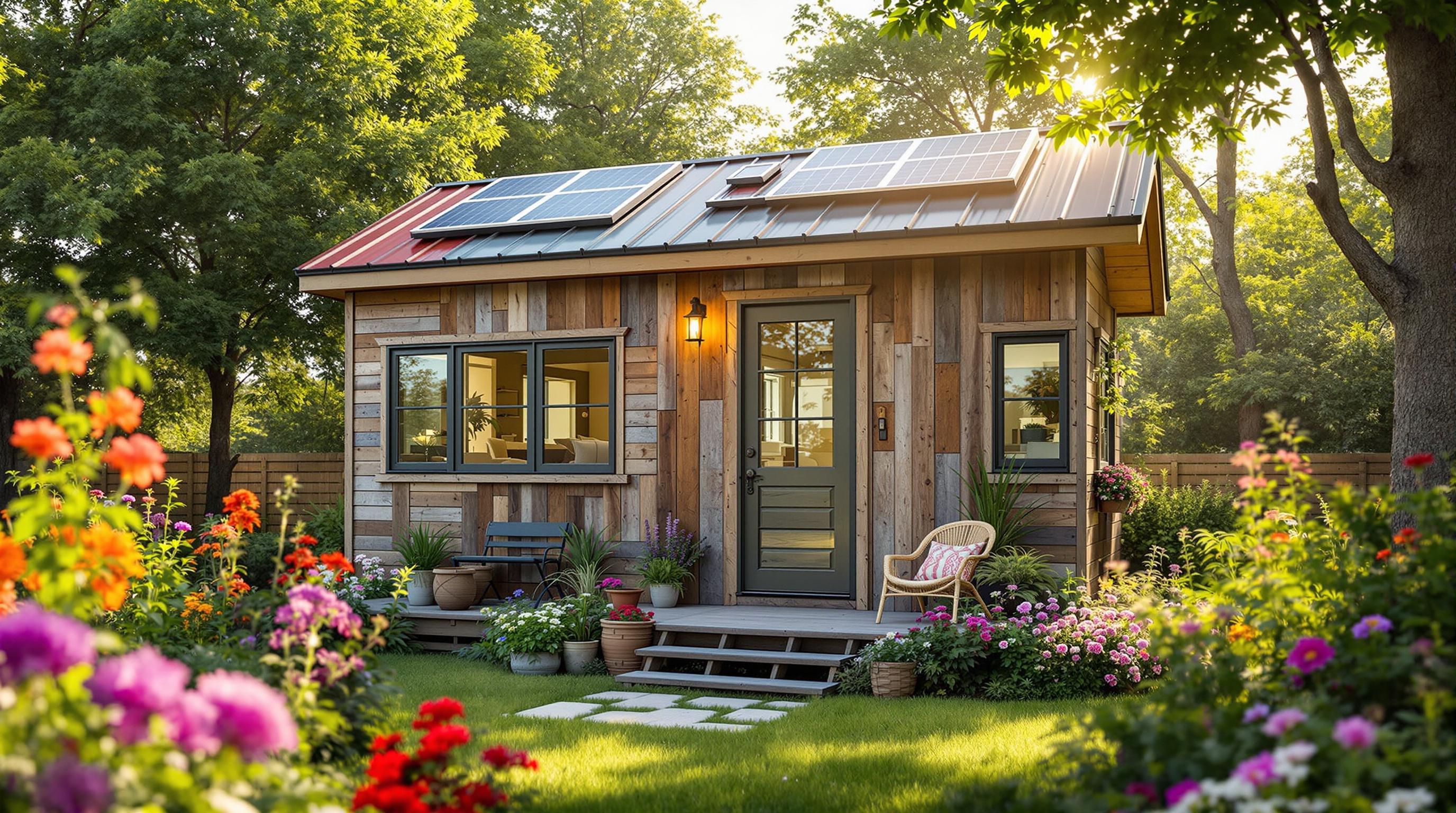Maintaining plumbing in a tiny home can be challenging, but the right tools make it much easier. Here’s a quick overview of five essential tools you’ll need to handle common plumbing issues in small spaces:
- Adjustable Wrench: Perfect for tightening or loosening various pipe connections in tight spots.
- Pipe Cutter: Ensures clean, precise cuts for materials like PEX, PVC, or copper pipes.
- Long-Reach Needle Nose Pliers: Ideal for gripping and adjusting small fittings in hard-to-reach areas.
- Duct Tape: A temporary fix for small leaks until permanent repairs can be made.
- Hole Saw: Helps create precise openings for plumbing installations without damaging surrounding materials.
With these tools and regular maintenance, you can avoid costly repairs and keep your tiny home’s plumbing system in top condition.
Related video from YouTube
1. Adjustable Wrench
An adjustable wrench is an essential tool for tiny home plumbing. Its movable jaw fits various pipe sizes, so you don’t need a whole set of wrenches cluttering up your limited space. In tiny homes, where plumbing systems are often compact and tricky to access, this tool's practicality and size make it ideal for maintenance tasks [1][2].
Key features include:
| Feature | Benefit for Tiny Homes |
|---|---|
| Adjustable jaw | Works with different pipe sizes |
| Compact design | Accesses tight spots behind fixtures |
You can use an adjustable wrench to tighten or loosen connections, install fixtures, or handle emergency repairs in cramped areas [5][3]. It’s a great tool for tackling minor issues quickly, helping you avoid expensive repairs through regular upkeep [1][4].
While this wrench is perfect for connections and fittings, pair it with a pipe cutter for clean, precise cuts when working with PEX pipes.
2. Pipe Cutter
A pipe cutter is a must-have for anyone maintaining or updating plumbing systems in a tiny home. Its compact size makes it perfect for tight spaces like under sinks or behind fixtures, where larger tools just won’t fit.
This tool provides clean, accurate cuts by rotating around the pipe, eliminating the hassle of using a hacksaw. Plus, it avoids creating messy metal shavings or debris that could clutter your limited space. A pipe cutter is ideal for working with materials like PEX, PVC, and copper pipes, delivering smooth, burr-free edges that reduce the risk of leaks or pipe damage.
For added convenience, look for a model with a built-in deburring tool. This feature saves space and makes the process even easier. When using a pipe cutter, always wear safety gear and ensure the pipe is properly supported to prevent accidents. Its straightforward design makes it beginner-friendly, so even those new to plumbing can handle basic repairs with confidence.
Once you’ve made those precise cuts, you’ll be ready to tackle those tricky-to-reach connections with the next tool.
3. Long-Reach Needle Nose Pliers
Long-reach needle nose pliers are a must-have for handling plumbing tasks in tight spaces, especially in compact living setups like tiny homes. Thanks to their extended handles and slim jaws, these pliers can easily grip and adjust small fittings tucked behind fixtures or beneath sinks. They’re perfect for tightening fittings or tweaking valves in spots that are otherwise hard to access - no need to take things apart.
Brands such as Channellock and Klein Tools are known for offering sturdy options. When choosing, focus on the length of the reach and the quality of the jaws. To keep them in good condition, always clean and dry them after use to avoid rust.
For safe use, follow these tips:
- Use proper lighting to clearly see your work area.
- Wear protective gloves to safeguard your hands.
- Maintain a steady grip to avoid slipping.
Once you’ve managed those tricky adjustments, you’ll be ready to move on to tools designed for quick fixes and temporary repairs.
sbb-itb-2ef3f3a
4. Duct Tape
Duct tape can be a quick fix for emergency plumbing issues in tiny homes. While it’s not a long-term solution, it can temporarily seal small leaks until a professional repair is possible.
Here’s how to use duct tape effectively:
- Turn off the water supply.
- Dry the area around the leak.
- Wrap several layers of tape around the leak, making sure to overlap at least an inch on each side. Press down firmly to create a seal.
For the best results, opt for waterproof duct tape specifically designed for plumbing. As Miller Plumbing & Drainage Ltd. notes:
"If the leak is small and surface-level, then duct tape can be used to seal up the area and prevent further leaks."
However, duct tape works best for minor, surface-level leaks. It’s not suitable for high-pressure pipes or as a long-term fix. Store it in a dry, easy-to-reach place to keep it ready and effective. For emergencies, duct tape can be paired with tools like pipe clamps or epoxy for a more secure temporary solution.
While duct tape can save the day for small leaks, the next tool offers a more reliable option for making precise adjustments to your plumbing system.
5. Hole Saw
A hole saw is a must-have tool when working on plumbing systems in tiny homes. Its design allows for precise cuts, which is especially important in small spaces where accuracy is key and minimizing damage to surrounding materials is crucial.
This tool features a circular saw blade with a central drill bit, making it effective on materials like wood, plywood, and plastic. For tiny homes, this precision ensures clean installations without unnecessary damage.
Here are some tips for using a hole saw safely and effectively:
- Match the size: Choose a hole saw that fits the pipe or fitting size to ensure accuracy.
- Wear safety gear: Always protect yourself and apply steady pressure to prevent accidents.
- Drill carefully: Use a steady pace to avoid binding or damaging the tool.
For durability and better performance, consider a bi-metal or carbide-tipped hole saw. These models are built to last and can handle a variety of tasks, from cutting openings for water supply lines to drainage and vent pipes. Regular cleaning and inspection of your hole saw will also help maintain its longevity.
As Miller Plumbing & Drainage Ltd. advises:
"If the leak is small and surface-level, then duct tape can be used to seal up the area and prevent further leaks."
A hole saw is essential for creating the openings needed to install or repair plumbing components in a tiny home. With tools like this, plumbing projects become easier to tackle, helping to maintain a reliable and efficient system.
Plumbing Maintenance Tips for Tiny Homes
Taking care of your tiny home's plumbing system doesn't have to be complicated. With the right approach and tools, you can keep everything in great shape. Here are some practical tips to help you out.
Preventative Maintenance
Staying ahead of potential plumbing issues is key. Here’s what to keep an eye on:
- Regularly check water pressure to avoid leaks and pipe damage. Installing a pressure gauge can help you monitor this easily.
- Inspect PEX connections and fittings every month for any signs of wear or leaks.
- Pay attention to unusual noises like banging or whistling, as these could signal air pockets or pressure concerns.
- Look out for slow drains, irregular water pressure, or damp spots on walls - these might indicate hidden issues.
Natural Cleaning Solutions
Skip the harsh chemicals that could harm your compact plumbing system. Instead, try these eco-friendly alternatives:
- Use a mix of baking soda and vinegar to tackle minor clogs.
- Pour lemon juice and hot water down your drains to keep them clean and smelling fresh.
Seasonal Protection
Changing seasons can impact your plumbing, so it’s important to prepare:
- Winter: Insulate pipes to prevent freezing.
- Spring: Check for any damage caused by winter weather and make necessary repairs.
- Summer: Use vent fans in bathrooms and kitchens to reduce moisture buildup.
- Fall: Drain outdoor lines before temperatures drop to avoid freezing.
Ventilation Requirements
Proper ventilation is essential for managing moisture in tight spaces. Consider these options:
- Install bathroom vent fans designed for small spaces to prevent mold and mildew.
- Use kitchen range hoods with suitable CFM ratings to handle cooking fumes.
- Place dehumidifiers in areas prone to high moisture, like bathrooms.
For more specific plumbing advice tailored to your tiny home, check out resources like Tiny Houses For Sale, Rent, and More at tinyhousesearch.com. They provide helpful information on local regulations and maintenance tips.
"Regular inspections can help prevent major problems and save on repair costs", says Miller Plumbing & Drainage Ltd. "Monthly checks of your plumbing system are essential for maintaining its efficiency and longevity." [1][2]
Conclusion
Taking care of your tiny home's plumbing system doesn't have to be overwhelming. With the right tools and a regular maintenance routine, you can handle minor issues before they turn into expensive problems. These five plumbing tools are must-haves for keeping your system running smoothly.
Using these tools regularly not only helps avoid costly repairs but also reduces risks like water damage and mold - issues that can be especially tricky in small spaces [2][6]. Staying on top of inspections and quick fixes ensures your tiny home remains a comfortable and safe place to live.
For more advice on maintaining your tiny home's plumbing or discovering additional resources for tiny house living, check out Tiny Houses For Sale, Rent, and More at tinyhousesearch.com. And remember, if an issue feels too complex, reaching out to a professional plumber is always a smart move.



